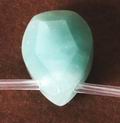
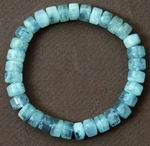

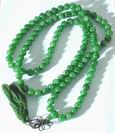
|
|
|
|
|
Aquamarine - March's
Stone + How are Beads Made, Mala Beads & More!
You have received this newsletter
because you opted after a past purchase, but should you wish to be taken off the
list, just click the bottom link. This month’s theme is March's birthstone
aquamarine + how are beads made, mala beads, and more.
Scroll down, or click one of the links below on the html version to go to a
certain section. If you have any suggestions for the future, please e-mail me
at
suggestions@mrbead.com.
To go to the
MrBead store click here
If you
weren't mailed this newsletter enter your e-mail address
here to receive next month's newsletter.
Aquamarine - March's Stone
How are Beads Made?
Mala Beads
Fun Bead Slogans!
Aquamarine is March’s stone – a blue-green gemstone from
South America, meaning Water of the Sea. The stone of sailors, believing it
protects them. Folklore also says that aquamarine protects against gossip, but
will pick up spirits. It is an excellent stone for meditation, bringing great
peace and serenity.
Aquamarine is the treasure of mermaids, and those legends have it that for
aquamarine to be truly powerful, it must be immersed in sea water and bathed in
sunlight. The gemstone is also supposed to have powers that reach to land too,
helping married couples solve their problems and drive off evil.
Aquamarine is associated with the thymus gland and is very soothing worn as a
necklace. It will also help coughs, reduce fluid retention and calm the nerves.
The Romans used aquamarine for stomach troubles and believed it could cure liver
and throat problems. Aquamarine brings courage, aids quick intellectual
response, and gives peace while protecting the aura.
Color ranges from a very light turquoise blue to a bluish green. Darker blue
colors are the best with greener being less valuable. Check the clarity of the
stone. Because aquamarine has a light pastel color, it is important that it be
free of flaws or inclusions. Examine the cut and check light reflects evenly off
the surface of the gem and that there are no scratches. Look at the stone from
several different angles to be sure.
Aquamarine is usually heat treated and sometimes irradiated. However, it will
become paler if left out in the sun. Clean aquamarine in with warm soapy water
and a soft bristle brush. As with all gemstones, protect from scratches and
sharp blows.
To see all aquamarine in our bead store click here to top
How are Beads Made?
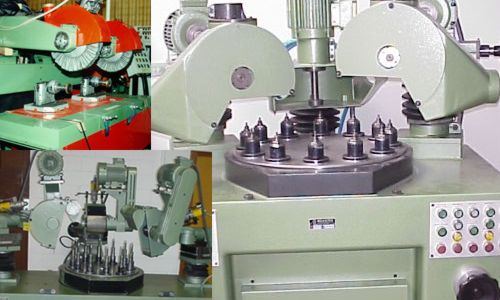
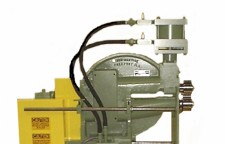
Surprisingly, there were no stone beads during the Stone Ages, people couldn't
work hard stone. It wasn't until about 5000 BC in India that hard stones such as
agates were first made into beads. The way in which they were turned into beads
has changed very little over 4000 years. Apart from electricity in the past
100-years, the previous important technological change was the introduction of
the double-tipped diamond drill, a discovery made over 2000 years ago.
The process of cutting and polishing gems is called lapidary. All gems are cut
and polished by progressive abrasion using finer and finer grits of harder
substances. Diamonds were among the first stones to be cut. Diamond, the hardest
naturally occurring substance is used to cut and polish the hardest stones.
India was once the major supplier of diamonds, and today still cuts more
diamonds by carat than any other country. Though the diamonds are mostly imports
now, the cutting is done in the same region beads were produced 4,000 years ago.
The small German town of Idar-Oberstein was famous for over two-hundred years
for the finest agate carvings in the world. Technicians in Idar-Oberstein used
to lay face down on a bench pressing the beads onto a stone grinding wheel, with
water running over the stone to soak the dust. These early faceted beads were
used in the African trade market. Molded beads are a more recent phenomenon,
appearing in 1829 at a trade fair in Prague.
Glass beads are more modern. Glass was not considered
worthy of polishing compared to stone. However, the German bead makers invented
“fire-polishing”. After the glass bead has been pressed in a mold and faceted
into the desired amount of cuts - it was ran through a furnace at extremely high
temperature to just melt the surface of the glass to gloss the faceted surface
of the beads…in effect polishing it. The original fire-polishing machine looked
like a 20-foot long metal box with a conveyor belt running through it. The beads
were placed on metal pie trays, one bead layer deep, and ran through the box.
After they cooled, any extra coatings would be dipped or sprayed, and then
either heated or baked.
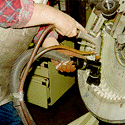 The
technique used today is basically the same, but the technician stands up
straight in front of the grinding wheel, which is about 8-feet in diameter. A
ratchet fixed to the wheel, has an attachable piece of equipment with multiple
holes in a line. The technician scoops this into a bucket of glass beads, and
the beads fall part way into the holes. He then secures the beads so they won’t
fall out, attaches the equipment to the ratchet, and presses it against the
revolving grinding wheel. Water is run over the wheel, and the bead is ground
for a few seconds, and then released. The ratchet is applied, the beads turn a
little, and pressure is again applied to the wheel on a new section of the bead.
This is done until the bead is totally faceted all the way around. The room in
which this is done might have up to 20 or more wheels, and the noise is
deafening.
The
technique used today is basically the same, but the technician stands up
straight in front of the grinding wheel, which is about 8-feet in diameter. A
ratchet fixed to the wheel, has an attachable piece of equipment with multiple
holes in a line. The technician scoops this into a bucket of glass beads, and
the beads fall part way into the holes. He then secures the beads so they won’t
fall out, attaches the equipment to the ratchet, and presses it against the
revolving grinding wheel. Water is run over the wheel, and the bead is ground
for a few seconds, and then released. The ratchet is applied, the beads turn a
little, and pressure is again applied to the wheel on a new section of the bead.
This is done until the bead is totally faceted all the way around. The room in
which this is done might have up to 20 or more wheels, and the noise is
deafening.
Once the beads are finished being coated, fire-polished and inspected, they are
strung on cotton thread. This can be done either by machine or by hand. Some
factories farm out the work to people in the local villages who supplement their
income by stringing the beads on a part time basis. The factory drops off sacks
of beads with instructions on how they are to be strung. For example: 25 beads
to a strand, 12 strands to a bundle , 4 bundles to a mass, x number of masses to
the sack. When the job is done, the factory comes back, picks up the beads, and
pays off the workers. Usually it is the women and children who do this work. If
the beads are round, they can use a machine that looks like a treadle sewing
machine, but with a large bowl on top. The beads are poured into the bowl with
12 needles are laid into it. The bowl is then spun around and beads get threaded
onto the needles and run along miles of thread. When a large amount of beads are
on the thread, the strands are measured off in the quantity required and tied
off.
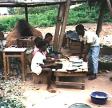

Some of the factories are so small that all the work is done cottage industry
style. The beads are pressed at one place by an experienced presser, then
shipped off to be faceted, then taken to a larger factory where it is
fire-polished, and then distributed to the stringers. If a coating needs to be
applied, the beads might first be sent to a coating facility, then baked, and
then strung. If the bead maker is too small to handle his own exporting, he will
take the beads to a packer for packing, and finally to an export agent who will
prepare the documents and handle the financing.
When you consider all the steps taken making beads, it’s amazing how inexpensive
they are to purchase!
Mala
Beads
 Although
these prayer beads are similar to the latest fashion accessories, they carry a
far deeper significance in the Buddhist culture. Prayer beads, or mala beads as
they are called in the Buddhist religion, represent a meditative tool. Their
purpose may vary, but commonly the beads are used to enhance 'goodness' and
diminish 'toxins'. Driving away evil and filling you and all beings with peace
and bliss. Buddhism teaches that this material object is used as an accomplice
for gaining merit on the path to enlightenment.
Although
these prayer beads are similar to the latest fashion accessories, they carry a
far deeper significance in the Buddhist culture. Prayer beads, or mala beads as
they are called in the Buddhist religion, represent a meditative tool. Their
purpose may vary, but commonly the beads are used to enhance 'goodness' and
diminish 'toxins'. Driving away evil and filling you and all beings with peace
and bliss. Buddhism teaches that this material object is used as an accomplice
for gaining merit on the path to enlightenment.
The origin of mala beads is the Hindu religion. Individuals who converted from
the Hindu faith to Buddhism during its birth, transferred this devotional
practice with them and it soon became a part of the Buddhism. The story of the
beads' origin is "Sakyamuni, the founder of Buddhism. He taught king Vaidunya to
thread 108 seeds of the Bodhi tree on a string, and while passing them between
his fingers to repeat... 'Hail to the Buddha, the law, and the congregation'...
2,000 times a day. Another interpretation of this prayer is 'om mani padme hum',
repeated over and over according to how many beads are on a person's mala.
There are 108 beads on a strand of mala prayer beads, because it represents the
number of sinful desires that one must overcome to reach enlightenment or
nirvana. Monks usually have mala beads with 108 beads, where as a lay person may
have a strand numbering in 30 or 40 beads. This difference in length may
possibly be explained by understanding each person's distance traveled on the
path to enlightenment.

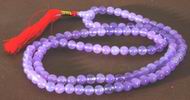
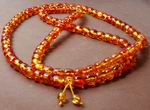

Just as variety exists for the number of beads, color and material can be
different. Typically, monks' mala beads are made of wood from the Bodhi tree. In
Tibet, mala strands often contain parts of semi-precious stones. In this
culture, the most valued strands are made of bones of holy men or lamas with 108
beads divided by 3 large beads. The end pieces on these strands are "djore" (a
thunderbolt) and "drilbu" (the bell). Representing the Three Jewels, or Buddha,
the doctrine, and the community. In China, mala beads was never really popular -
mainly used by the ruling hierarchy as a status symbol.
The overall purpose of all mala beads is to create a sense of tranquility and
inner-peace for not only the individual, but for the community as a whole. In
reciting the prayer, 'toxins' will leave and a sense of peace will enter making
an individual that much closer to reaching nirvana.
To see all our Buddhist Mala Necklaces click
here
To see our sister Oriental store with other Buddhist items click
here

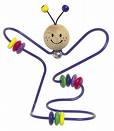
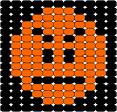
· Beads Beads Everywhere and Not a Drop to Drink
· Beads Happen
· Have You Hugged Your Beads Today?
· Twinkle, Twinkle Little Bead
· A Bead is a Terrible Thing to Waste
· Bead Long and Prosper
· To Bead or Not to Bead. That is the Question. To Bead is the Answer, duh!
· I Never Met A Bead I Didn't Like
· Will Work For Beads
· Beauty is in the Eye of the Beadholder
· Strung Out on Beads
· Life is uncertain, bead NOW!
· Don't Bead And Drive
· May the Force Bead With You
· I Like Finishing Necklaces -- KNOT!
· Make Beads Not War
· Beaders Do It Best
· It's Not Just a Bead; It's an Adventure
· So Many Beads, So Little Time
· Gone Beading
· I Bead, Therefore I Am
· Bead All That You Can Bead
· I'd Rather Be Beading
· Just Bead It!
· Visualize World Beads
· Beaded and Proud of It!
· Beads to Live By
· Blessed Beads
· Don't Worry, Bead Happy
· Love Me, Love My Beads
· She Who Dies With The Most Beads Wins
· Double Your Pleasure, Buy Twice As Many Beads
· Don't Be Beadless In Seattle
· A bead is a marble who lost her virginity
· I've beaded, and I can't get up!
· Beads, we bring good things to life.
· I feel the need, the need to bead.
· Sleep tight - don't let the bead bugs bite.
· Of beads and men..... Beads are the best.
· Bead to live. Live to bead.
· And the bead goes on!
· We all bead to a different drummer.
Special 15% Offer !
Sample our beads with 15% off any order from our MrBead bead store, just key in "mala" at the checkout (without the
inverted commas) and click "Redeem Coupon".
Offer valid until 6th March only - so act now! Only for use in our store at the checkout and not valid with any other offers.
To see all aquamarine in our bead store click
here
To see all our Buddhist Mala Necklaces click
here
To go to our MrBead store click
http://www.mrbead.com
To Top of Page
To return to the top of this page click here